The Manchester United midfield is renowned for his off-the-ball work, but what does he add with the ball? Varun Vasudevan investigates
Casemiro arrived at Manchester United at the end of August 2022 with a lot of fanfare, costing £70m and becoming the fourth signing of the Erik Ten Hag era. The midfielder search, which included a long chase of Frenkie de Jong and saw Adrien Rabiot linked at one point, ended with the 30-year-old Brazilian signing a 4-year contract before the window ended. After a settling-in period, it’s safe to say that Casemiro has found his feet. With numerous impressive performances for Manchester United in October and November and a good World Cup campaign in December, Casemiro has been proving his pedigree to fans of the Red Devils. But with that fanfare has also come a lot of debate, specifically around Casemiro and his ability in possession.
Hardly unusually for Manchester United debates, the takes are extreme. Some have argued that Casemiro is an excellent playmaker who never got the opportunity to showcase his skills thanks to being overshadowed by Toni Kroos and Luka Modric at Real Madrid, while others have stated that he’s a liability on the ball and only good for defending. As always, the truth is somewhere in between. And so in this piece I will try to bring nuance to Casemiro’s progression and explain what he’s good at and what he’s not so good at, when it comes to his progression.
What Casemiro is good at
I’m going to preface my explanation with three statements and then try to back them up as much as I can.
1) Casemiro is good at passes into the final third from the middle third
2) Casemiro is a progressive passer when facing the opponent goal
3) Casemiro is a good passer when he has time and space to pick a pass
Casemiro is good at passes into the final third from the middle third
The three phases of possession can be split into build up, progression, and creation. The type Casemiro is best at is in the second phase. He’s an excellent linker of defence and attack. When he picks up the ball in the centre of the pitch, he’s able to visualise how to get into the final third and has the technique to execute such a pass. These passes range from long switches to a wide player on the wing, penetrating grounded passes to an attacker in Zone 14 or a half-space, or a cheeky lobbed through ball into the box for the striker or winger to run into space behind the defence line. They help the team get into dangerous areas in the opponent’s half and are instrumental in breaking down a compact or organised block. In that sense, Casemiro is an excellent progressor.
To highlight his point, I split all of Casemiro’s progressive passes played this season for Manchester United into those played from the defensive third, middle third and attacking third.
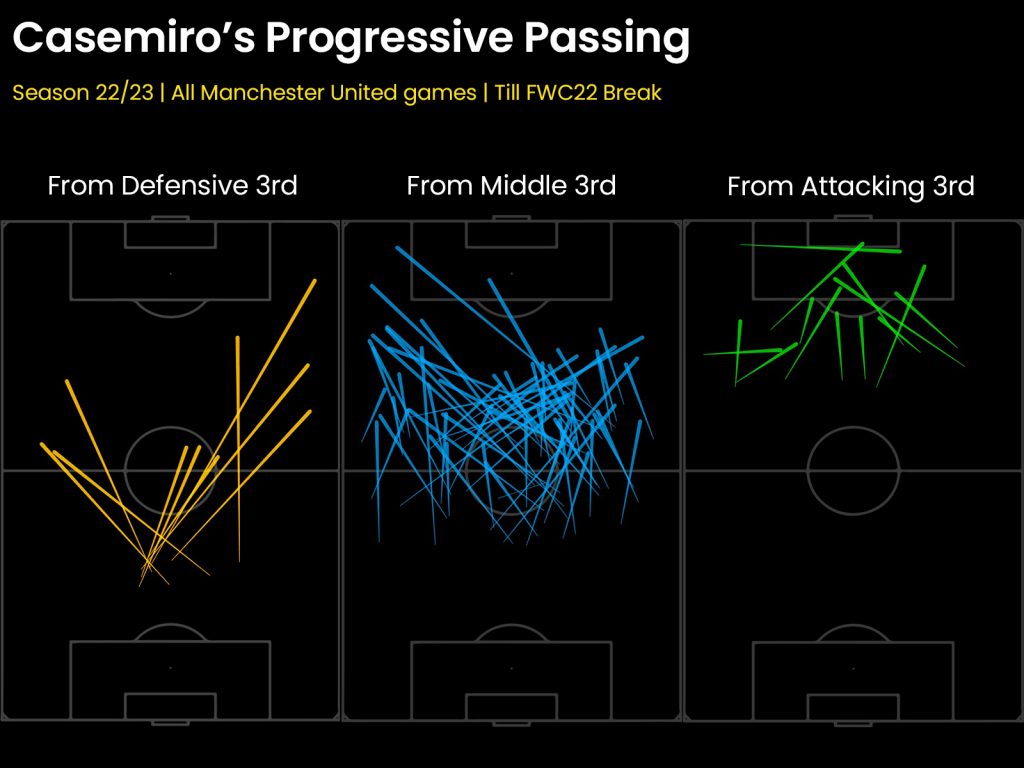
What really stands out is the second section of progressive passes played from the middle third. From this area, Casemiro boasts a large array of game-advancing passes. His favourite is the diagonal pass to a wide player, with the switch to the left hand side, where United often overload players, being a popular choice. Casemiro also displays some threatening passes from the attacking third, that are either final balls or last-but-final balls in the chance creation phase, which highlight his value higher up the pitch as well.
Casemiro is a progressive passer when facing the opponent’s goal
A lot of this progression comes when Casemiro is driving forward in the direction of the opponent’s defence. In that sense, Casemiro is a very ‘look forward, pass forward’ kind of player. While there exist many playmakers, who have the vision to pick out passes from awkward angles or without getting a clear view of the pitch (thanks to scanning before receiving a pass), Casemiro has the need to adjust his body to face the direction he wants to pass in before executing a pass. This means that phases of play where he’s not facing his own goal or receiving at awkward angles are more beneficial to get the best out of Casemiro. The ideal situation would be when a fullback or advanced midfielder passes back inside the centre of the pitch to find Casemiro receiving with his body towards the direction of attack.
Casemiro is a good passer when he has time and space to pick a pass
Casemiro operates best when he has space. The moments in a game where Casemiro is able to take a few touches and see his options or notice a player in the direction he is facing, without any pressure, he is able to execute a good pass. During build up, there are lots of times Casemiro gets back the ball after his marker has been dislocated, thanks to the work of others. With that new-found space, Casemiro has the comfort of setting himself up to advance the game. Most of his progressive passes arise in that fashion.
Let’s take a look at a few examples to highlight the above three points.
All the match-related examples in this article are from the same game (Manchester United 1-3 Aston Villa on 6th November, 2022) to highlight his pros and cons in a single game, and each gif is explained in the text underneath it.
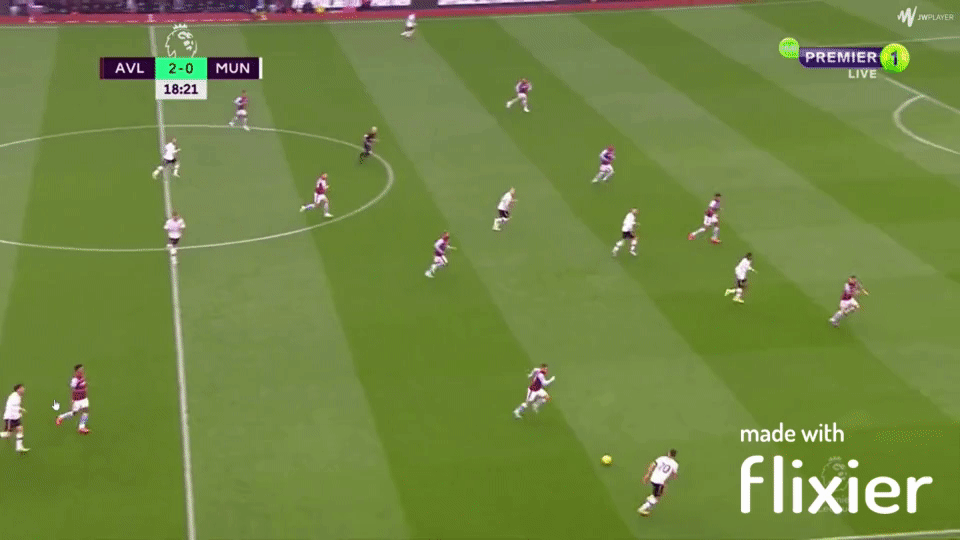
In this example, United progress down the right using Dalot, who then cuts back to Casemiro. Casemiro has the space and time to take a touch, set the ball towards his intended recipient and then play a switch ball to Garnacho.
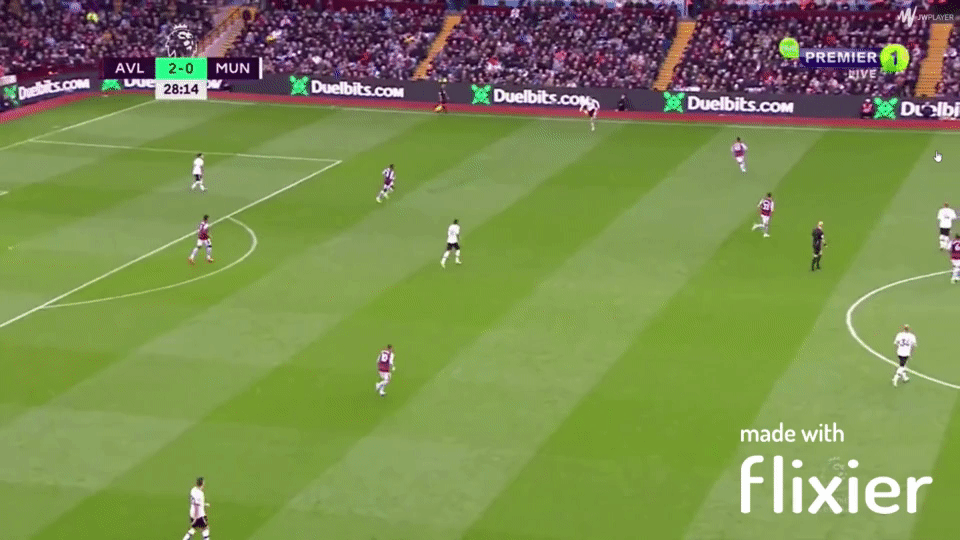
A similar case, but in mirrored fashion, here Casemiro receives from Shaw in a lot of space and has the time to turn, aim and belt out a good switch to Dalot.

Here, Dalot tees up Casemiro, who sets the ball while looking at his target and is then able to execute a great ball to the wide man, Garnacho.
What Casemiro is not good at (relatively speaking)
1) Casemiro is not good at first phase build up play in the defensive third
2) Casemiro is not good at receiving with his back to goal and carrying
3) Casemiro is not very secure in his passing
Again, I’ll explain each claim one by one.
Casemiro is not good at first phase build up play in the defensive third
Let’s look again at the progressive pass split:
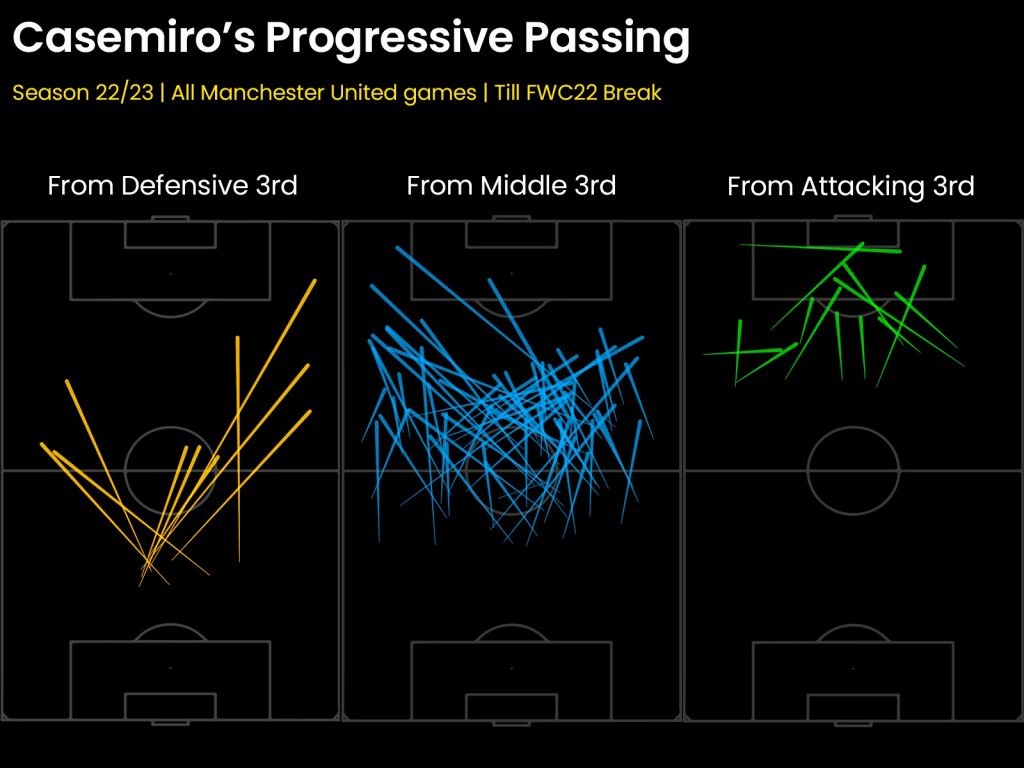
Casemiro actually has more progressive passes from the attacking third than the defensive third. United’s build up pattern this season has mostly consisted of ignoring Casemiro initially and bringing him in later in the second phase. The usual build-up route has 2 options – (1) De Gea or a centre-back going long to an attacker in a bid to win the second ball and force a transition or (2) Passing to one of the fullbacks and hoping they carry it out of their third. In the former case, Casemiro’s excellent ball-winning and combative nature means he often gets the ball and can kickstart a counter from the centre of the pitch. In the latter case, one of the fullbacks or midfielders cuts back to the centre, where Casemiro then has space to switch, as we saw in the examples above. But rarely does the first pass from the goalkeeper or centre-backs find Casemiro deep in United’s half while facing his own goal. And that’s because…
Casemiro is not good at receiving with his back to goal under pressure
The Brazilian’s ball control isn’t that great, while his ability to turn and carry himself out of pressure situations is also poor. In such situations, the best playmakers who play in a lone pivot, are either able to use smart body movement and scanning to pick out a quick pass to a fullback or midfielder (Busquets and Rodri are great at this) or are able to twist and dribble their way out of pressure (like Frenkie de Jong and Marco Verratti) to progress. Casemiro doesn’t have either trait. Even when he does help out in the build up phase, his trademark movement is to drop into the fullback areas, receive laterally from a centre-back and then set himself up to pick out a pass. His preference to drift towards areas where he is under lesser pressure and has the time to orient his body as per his passing angle, is obvious.
Let’s take a look at Casemiro’s progressive carries and pass reception zones:
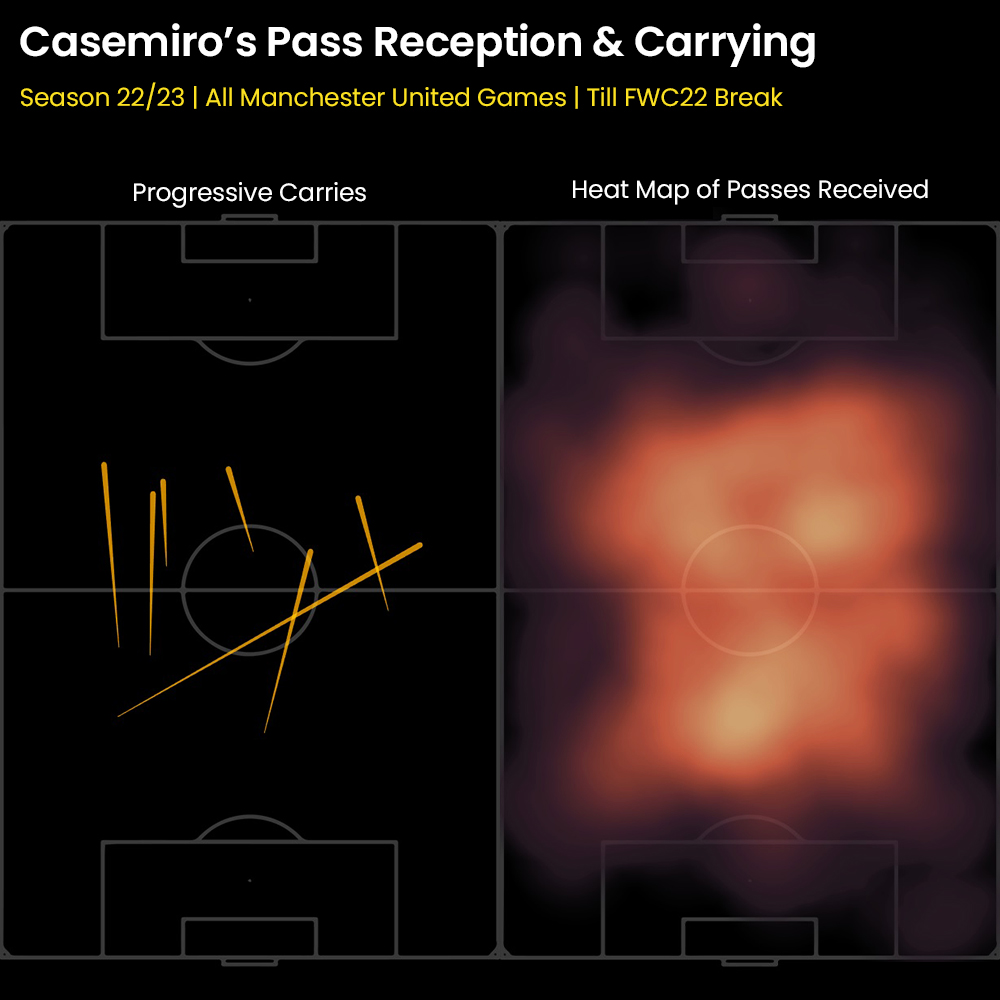
While he boasts almost a century of progressive passes this season, he only has 7 progressive carries, which highlight his limitations when it comes to carrying the ball. His pass reception heat map is well distributed, instead of being focused in the deep central zone where lone pivots usually receive the ball from their goalkeeper or centre-backs. Casemiro often prefers to go wide or ahead to receive the ball, and many of his receptions in the central deep zone are also the results of cut backs into midfield from the fullbacks.
Casemiro is not very secure in his passing
Casemiro’s pass completion percentage in the Premier League is only 79.3% this year. That puts him in the bottom fifth of all Premier League midfielders (as per FBref). This is low for a lone pivot midfielder. It is a result of his poor press-resistance, affinity to play ambitious switches and difficulty in finding a safe option quickly in tight situations. Coupled with Bruno Fernandes (75.1% pass % in the league this year) and Christian Eriksen (77.8%), this results in a very low retention midfield trio for Manchester United.
Below are a few match examples from the same game to highlight the above three points.

Under pressure after a quick pass from Eriksen, Casemiro mishits the pass to Garnacho. Ideally, the Brazilian would have wanted the time and space to set himself up, instead of attempting a first-time pass with an awkward body orientation.
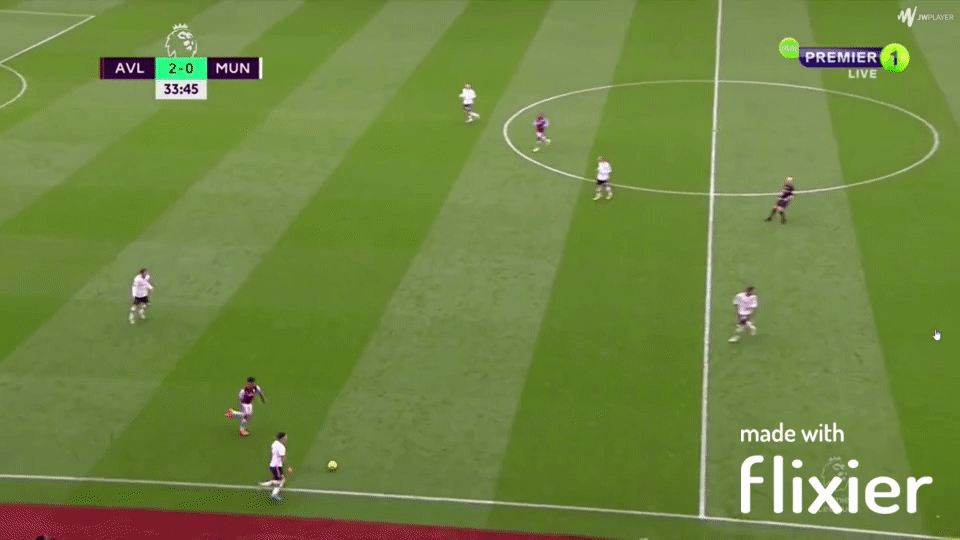
Even on occasions when Casemiro is under no pressure and has the time to set himself up, he is capable of the occasional miss-pass, which further explains his low passing security.

The above is a sequence which best explains United’s build up. De Gea is unable to play the ball into Casemiro (for longer than we could show in the gif, by the way). Casemiro is tightly marked and would find it tough to receive and carry out of that situation or execute a smart one-touch pass to the right-back from that angle. With both centre-backs covered as well, de Gea goes long in the hope to win a 50-50 on the wings.
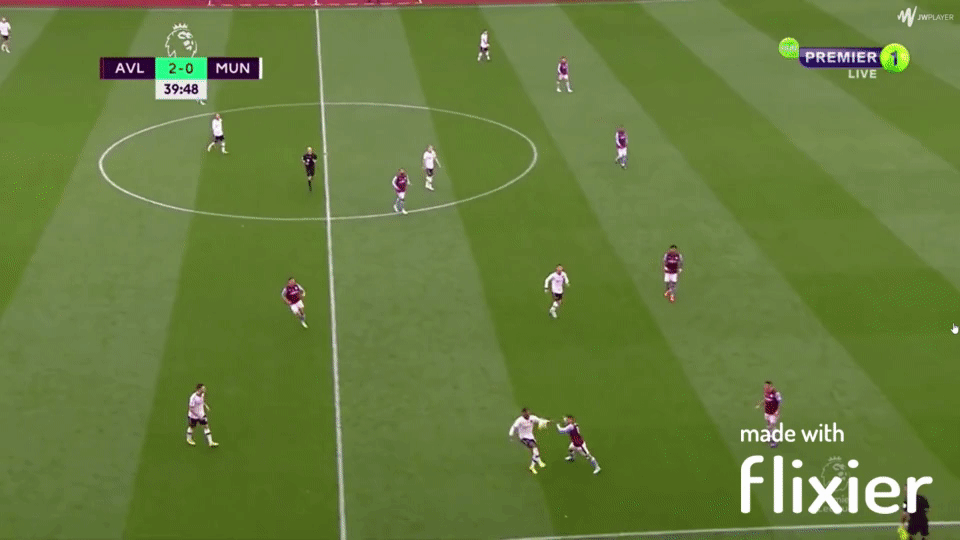
But the immediate duel win from Rashford helps him set up Casemiro, who is now free from his marker and has the time and space to release Shaw and help the team enter the final third. This sequence of events shows Casemiro’s strengths and weaknesses in possession.
How United can get the best out of Casemiro
The goal of every system is to maximise a player’s strengths and limit their weaknesses. With that in mind and with what we have learnt so far, United need to limit Casemiro’s involvement in build up when he is facing his own goal, not put him in under-pressure situations and involve him more in the second phase, where his excellent progression into the final third can be utilised. If we had to create the perfect complimentary midfield partner for Casemiro, a midfielder comfortable receiving the ball from his goalkeeper or centre-back when facing his own goal and good at carrying when under pressure, is required. The summer chase for Frenkie de Jong makes a lot of sense, with this in mind. That’s exactly the profile that would compliment Casemiro, and offer the build up ability, retention and carrying strength that United are missing in their midfield. Currently, Eriksen is playing that role and although the Dane’s adaptability and flexibility needs to be appreciated, he isn’t the safe and press-resistant deep playmaker that can get the best out of Casemiro.
The next step in United’s evolution would require that profile in midfield. Because if that happens, they can enjoy the best of Casemiro on the ball.
Header image copyright IMAGO/Craig Thomas/News Images














